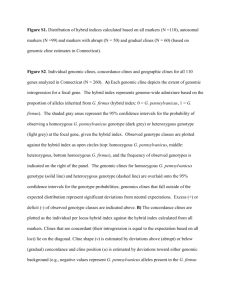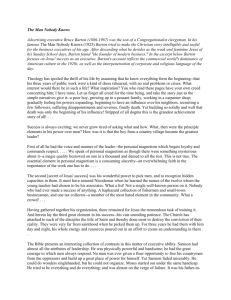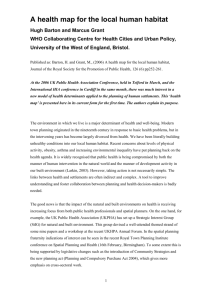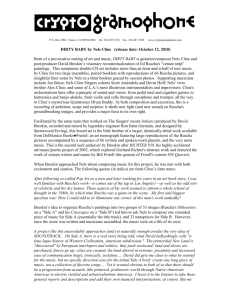Supplementary Methods (doc 48K)
advertisement
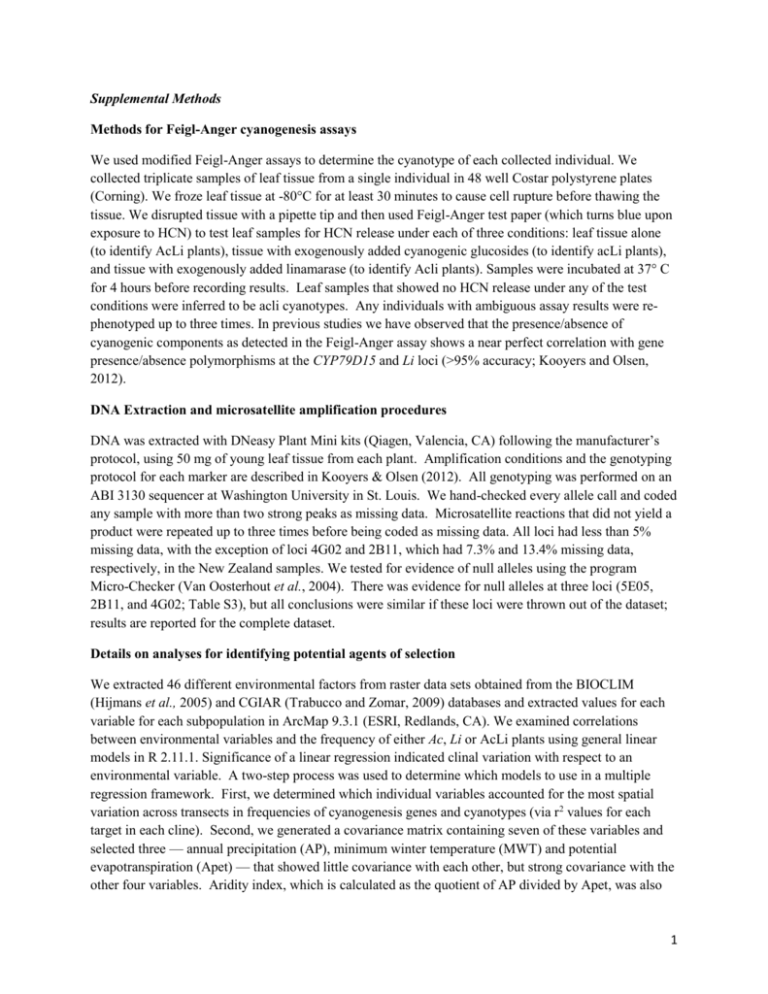
Supplemental Methods Methods for Feigl-Anger cyanogenesis assays We used modified Feigl-Anger assays to determine the cyanotype of each collected individual. We collected triplicate samples of leaf tissue from a single individual in 48 well Costar polystyrene plates (Corning). We froze leaf tissue at -80°C for at least 30 minutes to cause cell rupture before thawing the tissue. We disrupted tissue with a pipette tip and then used Feigl-Anger test paper (which turns blue upon exposure to HCN) to test leaf samples for HCN release under each of three conditions: leaf tissue alone (to identify AcLi plants), tissue with exogenously added cyanogenic glucosides (to identify acLi plants), and tissue with exogenously added linamarase (to identify Acli plants). Samples were incubated at 37° C for 4 hours before recording results. Leaf samples that showed no HCN release under any of the test conditions were inferred to be acli cyanotypes. Any individuals with ambiguous assay results were rephenotyped up to three times. In previous studies we have observed that the presence/absence of cyanogenic components as detected in the Feigl-Anger assay shows a near perfect correlation with gene presence/absence polymorphisms at the CYP79D15 and Li loci (>95% accuracy; Kooyers and Olsen, 2012). DNA Extraction and microsatellite amplification procedures DNA was extracted with DNeasy Plant Mini kits (Qiagen, Valencia, CA) following the manufacturer’s protocol, using 50 mg of young leaf tissue from each plant. Amplification conditions and the genotyping protocol for each marker are described in Kooyers & Olsen (2012). All genotyping was performed on an ABI 3130 sequencer at Washington University in St. Louis. We hand-checked every allele call and coded any sample with more than two strong peaks as missing data. Microsatellite reactions that did not yield a product were repeated up to three times before being coded as missing data. All loci had less than 5% missing data, with the exception of loci 4G02 and 2B11, which had 7.3% and 13.4% missing data, respectively, in the New Zealand samples. We tested for evidence of null alleles using the program Micro-Checker (Van Oosterhout et al., 2004). There was evidence for null alleles at three loci (5E05, 2B11, and 4G02; Table S3), but all conclusions were similar if these loci were thrown out of the dataset; results are reported for the complete dataset. Details on analyses for identifying potential agents of selection We extracted 46 different environmental factors from raster data sets obtained from the BIOCLIM (Hijmans et al., 2005) and CGIAR (Trabucco and Zomar, 2009) databases and extracted values for each variable for each subpopulation in ArcMap 9.3.1 (ESRI, Redlands, CA). We examined correlations between environmental variables and the frequency of either Ac, Li or AcLi plants using general linear models in R 2.11.1. Significance of a linear regression indicated clinal variation with respect to an environmental variable. A two-step process was used to determine which models to use in a multiple regression framework. First, we determined which individual variables accounted for the most spatial variation across transects in frequencies of cyanogenesis genes and cyanotypes (via r2 values for each target in each cline). Second, we generated a covariance matrix containing seven of these variables and selected three — annual precipitation (AP), minimum winter temperature (MWT) and potential evapotranspiration (Apet) — that showed little covariance with each other, but strong covariance with the other four variables. Aridity index, which is calculated as the quotient of AP divided by Apet, was also 1 subsequently used in some analyses. Multiple regression analysis was performed using lm () in R 2.11.1 with every combination of AP, MWT and Apet, as well as interactions among these variables. Models were compared using AIC values and adjusted r2 values; AIC values for each model were extracted using the extractAIC call. To determine whether all clines can be described by the same set of environmental variables, we combined all subpopulations from all transects into one dataset and re-ran multiple regression analysis to create a model that best predicts population variation in frequency of cyanogenesis genes and the cyanogenic phenotype. Cline shape analysis We assessed the parameter for the Ac allele, the Li allele and the AcLi cyanotype in each cline where z is the logit (allele frequency) or logit (cyanotype frequency) of a subpopulation and x is the minimum winter temperature (MWT) of a subpopulation. The parameter is inversely proportional to cline width and directly proportional to the slope of either the selection gradient or the selection coefficient (depending on whether a gradient or ecotone model is assumed) (Slatkin, 1973; Endler, 1977; Barton and Hewitt, 1985; Barton & Gale, 1993). We used the logit transformation of either allele frequency or cyanotype frequency because we leave the tail of the central U.S. cline in the analysis (i.e., the Wisconsin subpopulations; see Table S2). If no transformation is used, the non-linearity of this tail causes poor fit of the model and substantially changes the relationship between cline shape in the central U.S. and the cline shapes in New Zealand and Mt. Baker. This is the same transformation used in several previous studies of clines (e.g., Barton and Hewitt, 1989; Szymura and Barton, 1991). Since logit transformations cannot be performed on fixed allele frequencies, we used values of -5 and 5 in cases where frequencies were 0 or 1 respectively (see Szymura and Barton, 1991). The role of epistasis on cline shape at a single locus is difficult to predict without context (i.e., information on founding population allele frequencies), but cline shape should still be near linear on a logit scale as is empirically shown in snail shell band and color clines (Johnson, 2012). MWT was selected as the independent variable because it has previously been linked to herbivore abundance as the proposed agent of selection in the cyanogenesis system. It is a better measure than geographic distance because cyanogenesis clines are typically thought of as dispersal-independent clines – where populations in the middle of transects can adapt to local conditions because the ratio of gene flow to selection is low (Barton and Hewitt, 1985). In dispersal-independent clines, clines over similar gradients will generate similar cline shapes regardless of the geographic length of the transect over which an environmental gradient occurs; the cyanogenesis clines appear to fit model this well (Daday, 1958; see also results within the main text). References: Barton NH, Hewitt GM (1985). Analysis of Hybrid Zones. Annu. Rev. Ecol. Syst. 16: 113–148. Barton NH, Hewitt GM (1989). Adaptation, speciation, and hybrid zones. Nature 341: 497–503. Barton NH, Gale KS (1993). Genetic analysis of hybrid zones. Pp. 13-45 in R.G. Harrison, ed. Hybrid zones and the evolutionary process. Oxford Univ. Press, Oxford. 2 Daday H (1958). Gene frequencies in wild populations of Trifolium repens L. III. World distribution. Heredity 12: 169–184. Endler JA (1977). Geographic Variation, Speciation, and Clines. Princeton University Press: Princeton, New Jersey. Hijmans RJ, Cameron SE, Parra JL, Jones PG, Jarvis A (2005). Very high resolution interpolated climate surfaces for global land areas. Int. J. Climatol. 25: 1965–1978. Johnson MS (2012). Epistasis, phenotypic disequilibrium and contrasting associations with climate in the land snail Theba pisana. Heredity 108: 229–35. Kooyers NK, Olsen KM (2012). Rapid evolution of an adaptive cyanogenesis cline in introduced North American white clover (Trifolium repens L.). Mol. Ecol. 21: 2455-2468. Slatkin M (1973). Gene flow and selection in a cline. Genetics 75: 733–756. Trabucco A, Zomer RJ (2009). Global Aridity Index (Global-Aridity) and Global Potential EvapoTranspiration (Global-PET) Geospatial Database. CGIAR Consortium for Spatial Information. Published online, available from the CGIAR-CSI GeoPortal at: http://www.csi.cgiar.org/ Van Oosterhout C, Hutchinson WF, Wills DPM, Shipley P (2004) MICRO-CHECKER: software for identifying and correcting genotyping errors in microsatellite data. Mol. Ecol. Notes 4: 535-538. 3

